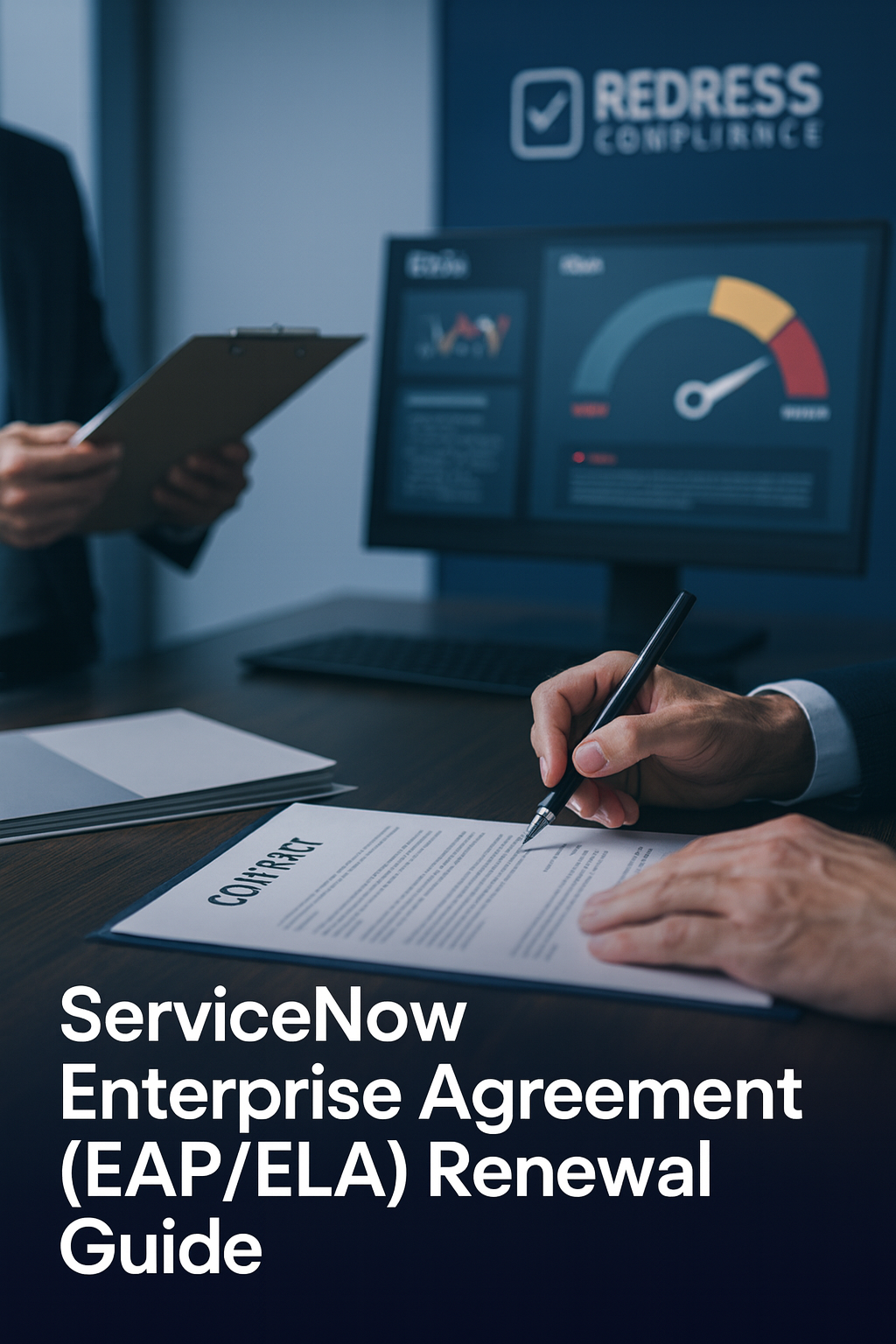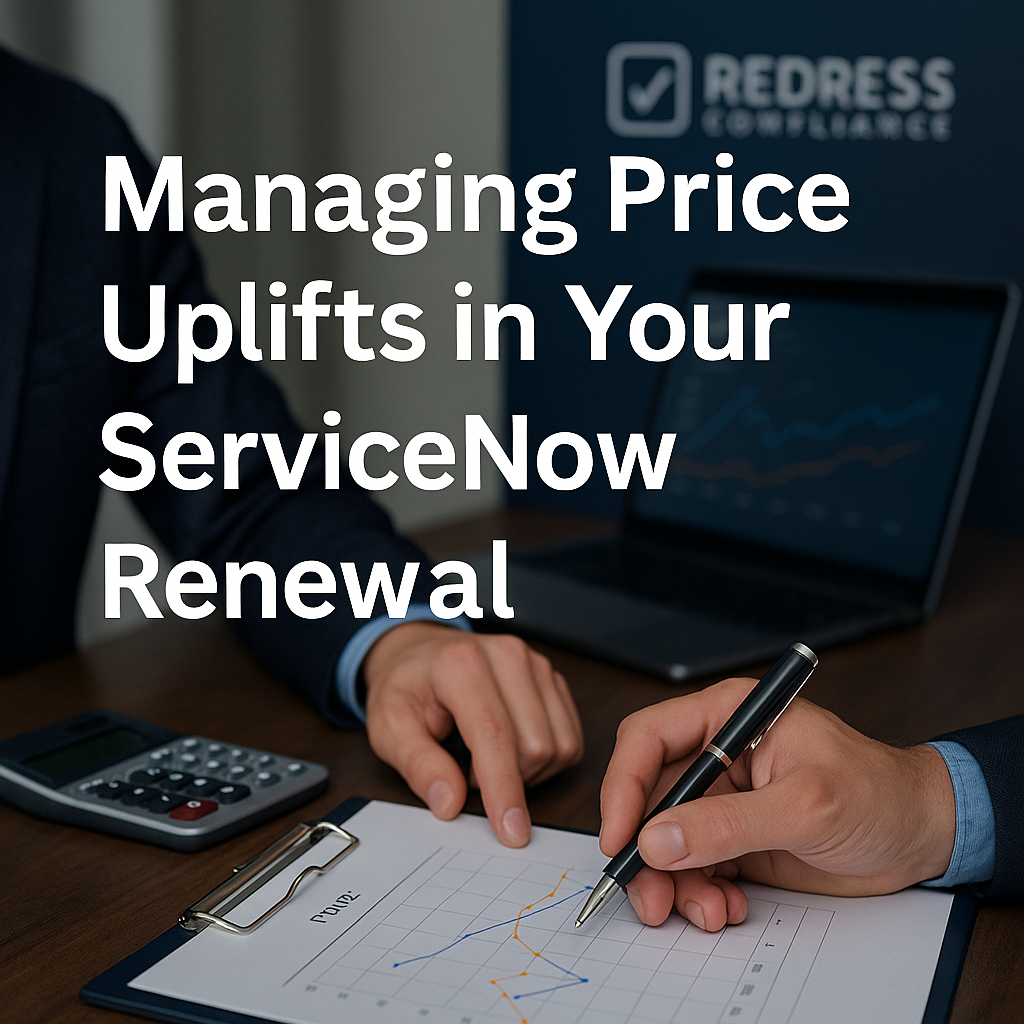Preparing for a ServiceNow EAP Renewal Review
Renewing a ServiceNow Enterprise License Agreement (ELA/EAP) is not a routine task – it’s a high-stakes negotiation. ServiceNow’s sales teams often begin plotting your renewal well ahead of time, armed with revenue targets and upsell plans.
To level the playing field, your ServiceNow renewal preparation must start early and be driven by your own data and analysis. By doing the homework months in advance and aligning internally, you set the terms of the discussion and keep control over your spend and terms.
Read our ultimate ServiceNow Enterprise Agreement (EAP/ELA) Renewal Guide.
Why Early Preparation Defines Your Leverage
ServiceNow itself starts planning renewals 9–12 months before your contract expires. By the time a quote arrives, they’ve set internal targets and assumptions. Starting just as early on your side lets you flip the script – you’ll shape the deal around your data and needs, not theirs.
Pro Tip: If a “renewal coming up” email just hit your inbox, assume ServiceNow is already months ahead internally. Don’t wait – mobilize your team now to catch up.
Step 1 – Gather Your Contract and Entitlement Data
Start by pulling together all your current deal documents. Locate your master ELA/EAP agreement, plus any order forms, amendments, and addenda. These form your baseline and map out your last deal.
Go through the contract and note the key terms:
- Dates: Contract end date and any notice period to prevent auto-renewal.
- Financial terms: Your current annual spend, any minimum spend or committed growth clauses, and any built-in price escalations for renewal.
- Entitlements: Exactly which products/modules and how many licenses or units you have, and what support level is included.
- Special clauses: Any negotiated exceptions – for example, rights to swap out unused licenses, one-time credits, or caps on renewal price increases.
This review tells you what you’re working with. Note where you got a great deal last time (flexible pricing or extras) and where terms were strict. These hints indicate what to push or watch out for this time.
Pro Tip: Your original contract is a roadmap to leverage. It shows where ServiceNow was previously set on terms and where they’ll likely defend their margins now.
Step 2 – Pull Real Usage and Adoption Data
Next, gather real usage data for every ServiceNow product in your environment. Export metrics from ServiceNow’s dashboards or your asset management tools that show how each module is actually being used. Focus on metrics like:
- Active vs. licensed users: How many users log in regularly versus how many licenses you pay for.
- Transaction volumes: Tickets, requests, or API calls handled (to gauge module activity).
- Infrastructure usage: For ITOM or similar, how many nodes/devices are monitored versus what you’re entitled to.
- Shelfware: Any modules or features with very few or no active users (licenses sitting idle).
These numbers will highlight gaps. If you’re paying for 500 HR service licenses but only 300 people use them, that 200-license difference is negotiating gold.
Mini-Scenario: One telecom found 42% of a module’s licenses unused. They cut that shelfware (about 25% of total licenses) at renewal and saved significantly.
Usage stats speak for themselves – they make your case objectively. Come negotiation time, you can anchor the conversation on hard data: what’s actually being utilized and what isn’t.
Pro Tip: Talk in terms of utilization, not just entitlements. Saying “we only use 60% of our licenses” is a powerful, fact-based argument when pushing for a better deal.
Step 3 – Assess Business and Technology Changes
Look ahead at any business or technology changes that could impact your ServiceNow usage in the next term:
- Organizational changes: Mergers, acquisitions, divestitures or even layoffs that will increase or reduce your user counts (and thus license needs).
- Process/tool shifts: New automation or alternate tools that might take over functions currently done in ServiceNow (potentially reducing your usage requirements).
- Planned expansions: New ServiceNow modules you intend to deploy (e.g., adding Customer Service Management or Security Operations) – with realistic adoption numbers, not sales-driven estimates.
Align your renewal scope to the company you will be in the next few years, not the company you were when you signed the last deal. If a department is being downsized or a function is moved to another platform, you might drop or shrink related ServiceNow licenses. If new initiatives are coming, consider adding a module – but start with a conservative license count and plan to grow if needed.
(Remember that your support level needs might change, too. For instance, if you now require 24/7 support or, conversely, can manage with a lower tier, factor that into the renewal.)
Pro Tip: Treat the renewal as a strategic reset. You’re recalibrating your ServiceNow agreement to fit your current business reality and future roadmap, not the past one.
How to manage price uplifts in your renewal: Managing Price Uplifts in Your ServiceNow Renewal.
Step 4 – Build a Financial Baseline and Forecast
Before negotiating, build a financial baseline and model a few scenarios. Calculate your current total spend (and break it down by product or module). Then compare cost to actual usage – this shows your cost per user or unit and highlights where you’re overpaying for unused capacity.
Next, model different renewal outcomes:
- Renew as-is: Keep the same scope (assume a typical ~5% vendor price increase).
- Right-size: Remove the unused 10–20% of licenses/modules and see how much you’d save.
- Go modular: If you have an enterprise bundle, consider buying only select modules individually (lower cost, though you lose some bundle perks).
For example, here’s a simplified comparison of scenarios:
| Renewal Scenario | Coverage | Cost Change | Risk/Notes |
|---|---|---|---|
| Same scope (status quo) | All current modules & licenses | +8% (est. uplift) | Low – no change (but pay more for same use) |
| Right-size (-20%) | Remove ~20% shelfware | -18% vs. now | Medium – ensure remaining licenses suffice |
| Go modular (no ELA) | Only key modules à la carte | -25% vs. now | High – more contracts; lose some bundle perks |
Run these numbers with your finance team and decide on a realistic target. For instance, you might set a goal to reduce overall costs by 10–15%. Having an approved financial goal from leadership gives you a clear bottom line when you enter negotiations.
Step 5 – Identify Negotiation Levers
With data in hand, pinpoint your key negotiation levers – the pressure points that can give you bargaining power. Common levers include:
- Unused licenses: If you’re over-licensed, plan to cut that fat. Remove those excess licenses from the renewal or push to swap them for credits or other products you do need.
- Low adoption products: If a module’s value never fully materializes, ask for special treatment. For example, extend “pilot” pricing into the renewal term or agree to pay more later only if adoption improves.
- Early renewal commitment: Willing to sign early? Use it. Offer to renew a bit ahead of deadline in exchange for an incentive – say, an extra discount or a cap on any price increase.
- Benchmark pricing: Arm yourself with any industry pricing benchmarks you can get. If you know companies of similar size got 30% off and you got 15%, leverage that to reset the discount level in this renewal.
- Flexibility for growth: If you plan to downsize now, negotiate the right to add licenses later at the same discounted rate. This way, you’re not paying for capacity now that you don’t need, but ServiceNow knows they can still sell you more when you grow.
For each negotiation ask, have a rationale ready (backed by data or business need) so ServiceNow sees your requests are justified. Instead of a wish list of demands, you’re presenting a logical case: “We need X because our analysis shows Y.”
Pro Tip: Make your asks business-minded. A request like “We need a price hold because usage dropped 30%” comes across as fair and fact-based – far more compelling than “We just want a better price.”
Step 6 – Secure Internal Alignment Early
Get internal alignment early so you present a united front to ServiceNow. Loop in:
- Finance: Set the budget cap or savings target and get leadership sign-off.
- IT: Confirm which modules are truly needed (and which aren’t). Validate the usage findings and agree on what can be trimmed or added.
- Legal/Procurement: Review the contract for renewal clauses (notice periods, audit terms, etc.) and prepare to negotiate any terms (liability, compliance, etc.) that need adjusting.
When all stakeholders back the plan, ServiceNow can’t play one off against another. Everyone internally should know the story: “We’re aiming for X outcome, for Y reasons.”
Mini-Scenario: A European bank’s team set a firm goal of a 10% cost reduction and unified behind it early. They refused any upsell outside that plan. Ultimately, ServiceNow conceded with a 3-year renewal that met the 10% lower budget.
Step 7 – Define a Renewal Timeline
Map out a proactive renewal timeline counting back from your contract end date so you’re never rushed. For example:
- T–180 days (6 months out): Complete your internal data review and have a draft strategy. Also, send notice to cancel any auto-renewal if required.
- T–120 days: Finalize objectives internally. Let ServiceNow know you intend to renegotiate (so they shouldn’t assume an auto-renew). Begin any pricing benchmark efforts now.
- T–90 days: Ask ServiceNow for their initial proposal. Share your expected needs (e.g., which modules you’ll renew or drop) to guide their quote.
- T–60 days: Push back on the quote with your data-backed counter. If their offer misses the mark, escalate or get your backup plan ready.
- T–30 days: Aim to finalize the deal by now. If you can’t, activate your backup plan (like a short extension) rather than accepting a bad last-minute deal.
Stick to your timeline with regular internal check-ins. Controlling the schedule reduces ServiceNow’s ability to squeeze you at the last second.
Pro Tip: Don’t let the clock run out. Vendors bank on customers getting desperate near deadlines. Be willing to walk away or extend the status quo if needed – it defuses the time-pressure tactic.
Step 8 – Draft Your Renewal Briefing Pack
Finally, consolidate everything you’ve gathered into a concise renewal briefing pack for your internal team and executives. This playbook ensures everyone is on the same page. Include items like:
- Contract summary: Key contract facts (end date, products and modules, current spend, any special renewal clauses).
- Usage report: Summary of your utilization analysis (active usage vs. entitlements for each major area).
- Financial analysis: Your current baseline costs versus the optimized scenario you plan to negotiate toward.
- Negotiation targets: The specific outcomes you’re aiming for (discount levels, term changes, etc.) and the justification for each.
- Risks & contingencies: Known risks (e.g., true-up or audit possibilities, compliance concerns) and your fallback plans (such as a temporary extension if a deal isn’t reached in time).
Keep the briefing pack factual and to the point – think of a short slide deck or memo. With this in hand, management can quickly approve your strategy. When it’s time to actually engage with ServiceNow, you’ll have a clear, unified game plan to follow, backed by data and agreed on by all stakeholders.
Five Actions to Get Renewal-Ready
If your ServiceNow renewal is on the horizon, here are five immediate actions to kick off your preparation:
- Review your current contract. Note the end date, any auto-renewal clauses, price escalation terms, and special provisions.
- Audit your ServiceNow usage. Identify how many licenses are actually in use for each module, and flag any significant shelfware.
- Model a right-sized renewal. Calculate the costs for renewing “as-is” versus cutting out unused licenses, so you know your savings potential.
- Set your negotiation targets. Define the discounts, price caps, or contract changes you need, and establish your walk-away limit upfront.
- Notify ServiceNow early. Don’t let the deal auto-renew – inform your rep that you intend to review and renegotiate the terms.
Preparation is your discount. Every number, clause, and usage stat you pin down ahead of time becomes leverage once renewal negotiations begin.
Read about our ServiceNow Negotiation Services


